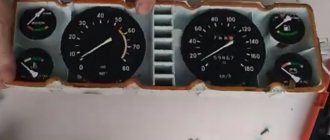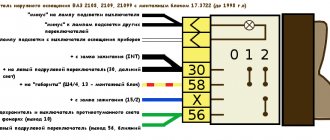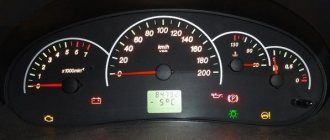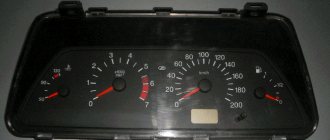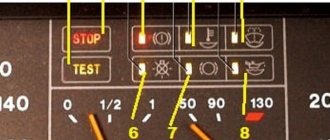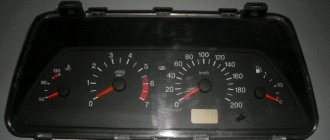- The parking light indicator of the VAZ Priora is flashing on the instrument panel - 10 answers
- Battery lights up on devices in Priora - 5 answers
- Devices stopped working after replacing the backlight bulbs - 3 answers
- The rpm needle rises when the ignition is turned on - 3 answers
- Coolant temperature sensor in a Priora with air conditioning, why is it acting up? – 2 answers
Electric power steering indicator (optional) - lights up orange when the ignition is turned on and goes out after the engine starts (the more the car's wheels are turned when the ignition is turned on, the longer the indicator does not go out.
Check the brake fluid level, top up.
If icon 14 is electric power steering. After starting the engine, it should go out, and if it lights up after starting, this is a malfunction of the electric booster.
Details if needed.
23 ABS fault warning lamp
Subscribe
to our channel in
Index.Zen
Even more useful tips in a convenient format
Tachometer, speedometer, on-board computer indicators, light bulbs - all these components are located on the Lada instrument panel. The “tidy” is designed to display the current state of various Lada Priora systems. An experienced motorist will immediately notice that one of the components requires repair; a certain icon will inform him about this. If you are a novice driver, then it will be useful for you to study the Lada Priora dashboard. This material provides a detailed description of each element of the tidy.
Dashboard indicator symbols
When starting up, almost all the icons on the dashboard light up - this way the operation of the light bulbs is checked. Some drivers believe that these are messages about malfunctions of some Lada Priora systems.
| No. on the diagram | Indicator designations |
| 1 | Tachometer. The device measures the engine crankshaft frequency (revolutions per minute). If the arrow goes beyond the red value, it means that the Lada Priora engine is operating in a dangerous mode; |
| 2 | Brake force distributor indicator. Reports defects in the operation of this node; |
| 3 | Battery charge. If the lamp lights up while the engine is running, the battery is discharged; |
| 4 | Left turn signal. The sign flashes when there is an alarm or the left indicator is on; |
| 5 | Speedometer. The device reports the speed at which your Lada Priora is currently moving; |
| 6 | Emergency lubricant pressure in the engine. If the sign lights up during operation of the power plant, it means the pressure in the system is low; it is highly not recommended to operate the engine in this condition; |
| 7 | Right turn signal (see No. 4); |
| 8 | Handbrake indicator. Lights up yellow if the Lada Priora is in the handbrake; |
| 9 | Antifreeze temperature in the cooling system. The operating temperature of the motor starts from 90° and above to the red mark. If overheating occurs, turn off the engine; |
| 10 | Gasoline level in the tank. If the fuel level approaches the minimum, the fuel pump may break; |
| 11 | Reserve gasoline level. The indicator lights up when there are less than 10 liters left; |
| 12 | Key for resetting the daily mileage and switching between display modes; |
| 13 | Alarm. If you have triggered the emergency lights, the lamp will flash along with the turn signal arrows; |
| 14 | Malfunctions in the electric amplifier. If defects appear in the EUR, the lamp will light up while the engine is running; |
| 15 | High beam designation. An active indicator indicates that you have switched to distant; |
| 16 | Outdoor Lighting. The system notifies the driver about the operation of the headlights or low beams; |
| 17 | Airbag malfunctions. If the lamp lights up after starting, then there is a high probability that the airbags will not deploy in a collision; |
| 18 | Immobilizer. An audible signal and flashing indicate that the immobilizer system is faulty; |
| 19 | Computer screen. Here you can view information from the bookmaker, as well as find out the total and daily mileage; |
| 20 | Indication of unfastened seat belts. The buzzer will signal a violation for 90 seconds; |
| 21 | The brake system is in disrepair. Most often these are worn pads or insufficient fluid in the system; |
| 22 | Disabling a specific airbag; |
| 23 | Indicator of defects in ASB operation, the braking system is operating normally; |
| 24 | Check Engine – there is a breakdown in the engines; diagnostics and subsequent repairs are urgently required. |
How to choose an LED lamp?
From my own bitter and costly experience, I can say that lamps can be selected according to one of the following principles, arranged in descending order of guarantee of a good result:
- In an auto store, purchase a branded LED lamp from a well-known brand (Osram, Philips, etc.) with a guarantee.
- In an auto store, buy a lamp from a lesser-known brand with a stated one-year warranty.
- Buy an LED lamp with an operating voltage range of 12–24V at an auto store or order online. Universal, that is, suitable for trucks, the lamp should work flawlessly at 14.8 volts in a passenger car.
- On the Internet, try to choose a lamp with a metal radiator and it is very desirable that its operating voltage range is indicated as 8.0–14.5 volts.
- Choose the cheapest plastic one. Buy a whole grain and prepare to change it every other day.
The exclamation mark is on - what to do?
We have noticed that new topics often appear on car forums where drivers ask about the exclamation marks that are displayed on the Lada Priora panel. They rarely specify where it is lit and what is depicted on the icon. In this section we have collected a small FAQ Below are all the exclamation marks that can light up on the instrument panel of a VAZ 2170 car. The designations of these icons are as follows:
- The red exclamation mark in the circle (bottom) is lit. The indicator indicates that there is a problem with the vehicle's brake system. This is usually a low brake fluid level. Add it to the tank and, most likely, the sign will stop lighting. If this does not happen, then it is worth checking the system for damaged components. When igniting, the indicator lights up for 4 seconds and then goes off.
- The red exclamation mark in the triangle/circle (above) is lit. Modern versions use a triangle instead of a circle. The indicator tells us about defects in the operation of the brake force distributor. Use extreme caution if the light comes on while driving.
- Exclamation mark next to the steering wheel icon. When illuminated for a long time, it indicates a malfunction in the electric power steering (EPS). Like other icons, it lights up when ignited and goes out after a few seconds if the system is working properly.
Sometimes the indication is caused by faults in the electronics. Terminals are coming off, contacts are oxidized, defects in the on-board computer are a few reasons for the random appearance of icons. To avoid damaging one of the systems, check the electronics first. To do this, it is enough to dismantle the device on the Lada Priora and see if the terminals are securely seated in the sockets. If the brake system indicator lights up, first check the fluid level in the reservoir, and only then fill in new antifreeze.
PRINCIPLE OF OPERATION OF CARS WITH ECM (ELECTRONIC ENGINE CONTROL SYSTEM)
Cars with conventional carburetor engines have been replaced by cars in which fuel enters the cylinders through a system of nozzles (injectors). And sparking occurs not in the distributor (distributor), but in a special ignition module. This rather complex system is controlled by a special intelligent unit. You could say it's a computer. It is he who sends signals to trigger all actuators. Therefore, the entire ECM system can be divided into three parts.
- Computer (ECU).
- Actuators (injectors, spark generators, etc.).
- Sensors (Air, oxygen, throttle opening, crankshaft position, etc.)
In what cases is it necessary to remove the instrument panel?
Dismantling the Priora tidy is required for tuning or replacing burnt out lamps. The VAZ 2170 is a modern model, so there are not many fastenings on the panel. To disassemble you will need a set of screwdrivers. Don't forget to turn off the negative battery.
- The process begins with removing the mounting block. To do this, you need to turn the latches on the fuse cover and then remove it;
Online magazine about car repair and operation
- Home /
- Questions and answers /
- Body and interior /
- Icons on the Priora dashboard
Fuses and relays in Lada Priora, electrical diagrams
Lada Priora is another car in the line of new VAZ cars, which is gaining popularity among segments of the population
External similarities with the 10th model attract the attention of young people; the relatively low price is also a reason for purchase for most car enthusiasts. Along with the growth in popularity, the owners of this model are gaining experience in repair and maintenance, which is becoming more and more every year.
If your Priora has electrical problems, do not rush to get upset; first, check the fuses and relays in your Lada Priora. These are the ones that will be discussed in this article.
Icons on the Priora dashboard
Please describe the icons on the Lada Priora instrument panel.
- Tachometer . Crankshaft rotation speed. The needle must not go into the red zone. The red zone is dangerous for the engine.
- Brake force distributor malfunction lamp . Lights up red for a few seconds when the ignition is turned on. If the lamp lights up in other cases, this may indicate a system malfunction.
- Battery charge lamp. Lights up red when the ignition is turned on and goes out immediately after the engine starts. If it lights up even after starting the engine, this indicates that the battery charge has expired/the battery is faulty.
- Left turn indicator. Flashes when the turn signal is on, also flashes when the hazard lights are on.
- Speedometer. Shows the speed of the car.
- Emergency oil pressure lamp. Lights up red when the ignition is turned on and goes out immediately after starting the engine. If the lamp is lit in any other case, this indicates low pressure in the system. Operating the car in this case is dangerous for the engine.
- Right turn indicator. Flashes when the right turn signal or hazard warning lights are on.
- Parking brake. Lights up red when the handbrake is applied.
- Coolant temperature indicator. Under normal conditions, the needle is located in the middle of the scale. Engine operating temperature is 90 degrees and above to the red zone. The arrow should not fall into the red zone, which indicates engine overheating. In this case, it is prohibited to further operate the car. You can continue using the car as soon as the needle drops to normal values.
- Fuel level indicator in the gas tank. P shows the fuel level. If there is no gasoline, the fuel pump may fail.
- Fuel reserve lamp. Lights up when there is less than 10 liters of fuel left in the tank. Also, a beep sounds.
- Button for switching display modes and resetting the daily mileage counter. To reset the daily mileage, hold the button pressed for 3 seconds.
- Alarm. Flashes along with turns when the emergency lights are turned on.
- EUR malfunction icon. Lights up yellow when the ignition is turned on for a few seconds and goes off. In other cases, if the lamp is lit, it indicates a malfunction of the EUR.
- High beam headlight lamp.
- Lamp for turning on external lighting. Lights up when the headlights and low beam are turned on.
- Airbag system malfunction icon. Lights up yellow for a few seconds when the ignition is turned on and goes off. If the lamp burns in any other cases, it may indicate a malfunction in the airbag system.
- Immobilizer icon. Lights up or flashes yellow and displays the status of the immobilizer system and the vehicle's security mode. If the system is in order and the engine is allowed to start, when the ignition is turned on, the lamp flashes 1 time and goes out.
- LCD display of on-board computer. Displays information from the on-board computer, as well as daily and total mileage.
- Unfastened seat belt. Lights up when the ignition is turned on if the driver's seat belt is not fastened.
- Brake system emergency lamp. Lights up red when the ignition is turned on for a few seconds and goes out. The lamp also lights up when the brake fluid level is insufficient and when a malfunction occurs in the service brake system.
- Passenger airbag deactivation icon (optional). Lights up when the ignition is turned on.
- ABS fault icon (optional). To check, the lamp lights up when the ignition is turned on and goes out after a few seconds or after the engine starts. If the lamp is lit, there is a malfunction in the ABS system. However, the performance of the braking system is not affected.
- Engine fault lamp. Check Engine. To check, it lights up when the ignition is turned on and goes out after the engine starts. In other cases, the lamp is lit indicating an engine malfunction. It is not recommended to operate the car in this case.
conclusions
To prevent the flickering of LED lamps in a car from being an unpleasant surprise, you need to follow two simple rules:
- do not place them near very hot headlight lamps;
- Do not operate LED lamps without a properly selected stabilizer.
An inexpensive LED controller with a suitable output current and power can be used as a current limiter. Due to its small size and sealed housing, such a device will be more effective than a resistor.
Source: ledjournal.info
Story
One theory of its origin is that it was the Latin word for joy ( Io
), written with the letter "I" above the letter "o".
The exclamation mark was introduced into English typography in the 15th century and was called “sign of admiration or exclamation” or “note of admiration” until the mid-17th century. In German orthography, this sign first appeared in the September Bible
in 1797.
The mark was not found on regular typewriters until the 1970s. Instead, they would type a period, backtrack one character, and then type an apostrophe.
The exclamation mark first appeared in the Catechism of Edward VI, printed in London in 1553.
What can you check yourself if the ABS light comes on?
The first thing you can do on your own in such a situation is to go to a car wash and ask for a good wash of the rims. Often, this intensive pressure washing can clean the ABS sensors located near the brake discs. On your way to the car wash, you can perform another simple test. Accelerate to a speed of 80-90 kilometers per hour, close the windows and turn off the music. If in this driving mode you hear a slight or annoying hum in the area of the wheels (front or rear), the likely cause of the light is a failure of the wheel bearing. There are several other things you can do:
- inspect the fuse box and replace the module that is responsible for the operation of the anti-lock braking system;
- if possible, read the diagnostic error code and read about it on the forums;
- to a specialist, describing your situation, and then try to correct the error yourself;
- get to the ABS sensors yourself by jacking up the car and removing the wheels to check their cleanliness;
- inspect the electronic control unit located under the hood, check that there is no liquid in it or on it;
- the best solution is to go to a service station and pay for diagnostics of the car's anti-lock braking and electrical systems.
The last step will definitely be the most correct, since you will receive a clear answer to your questions, you will be able to determine the repair budget and the presence of serious problems. This is the only way to completely get rid of problems with the diagnostic system light on and other unusual behavior of the car. It is enough just to connect computer diagnostics with an advanced program and test the car for possible errors. Within a few minutes you will receive the necessary information and can begin to fix the problem yourself or professionally.
Kalina
If a red exclamation symbol inscribed in a triangle lights up, this may indicate a malfunction of the brake drive. This is usually caused by a critical drop in fluid in the expansion tank. To eliminate the indicator, simply add the product to the required level.
Also on 2008 versions, the pointer may be accompanied by sound signals and additional lamps flash. This may be caused by a third-party option and can be specifically determined by checking the circuit.
If the light blinks, the reason is hidden in a system error or outgoing contacts. Diagnostics is performed by eliminating loose terminals and connecting a computer.
Why does the indicator light up?
Yellow color indicates failures, red indicates an emergency situation. In both cases, the exclamation mark on the car panel lights up according to the following principle:
- Car sensors use sensors to record the operating status.
- If the parameters deviate from the standard ones, an impulse is sent to the on-board computer.
- The ECU receives the signal and recognizes the type of fault.
- The head unit sends an impulse to the instrument panel, where a light indication appears.
The ECU can block the functionality of the system and turn off the engine if critical failures are detected. In such a situation, the driver will not be able to start the power unit until the problem is fixed.
conclusions
To prevent the flickering of LED lamps in a car from being an unpleasant surprise, you need to follow two simple rules:
- do not place them near very hot headlight lamps;
- Do not operate LED lamps without a properly selected stabilizer.
An inexpensive LED controller with a suitable output current and power can be used as a current limiter. Due to its small size and sealed housing, such a device will be more effective than a resistor.
Source: ledjournal.info
VAZ
For domestic cars, where the quality of on-board wiring leaves much to be desired. The presence of exclamation marks on the dashboard is considered the norm among car enthusiasts. In this case, independently, an 8-valve carburetor or a 16-valve injector is installed under the hood. In the classic type 2105/07, the indicator indicates a brake failure or a raised handbrake. The exact value depends on the year the car was built.
For more modern versions of the type:
- 2112;
- 2114;
- 2110;
- 2115;
- 2111;
- 2112.
The indicator may indicate a malfunction in the ABS module or the electronic brake force distribution system. The second value is that the float sensor in the brake line expansion tank is acting up.
In some cases, a lit icon may draw the motorist’s attention to the dashboard, where there is another indicator


